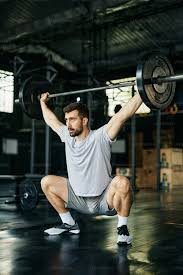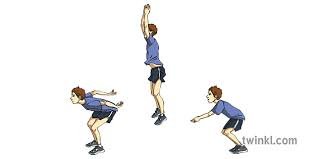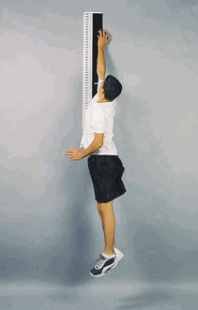6 Best Squat Exercises To Improve Your Vertical Jump
Squats are known to do a fantastic job at improving the strength of your lower body, but they can also do a lot for your vertical jump. Regardless of the type of sport, a high vertical jump shows off explosive power and translates to better performance. Whether you want to dunk a basketball or spike a volleyball, you should try to increase your vertical jump and see how it will take your game to new heights (literally!).
We’ll give you the best squat exercises there are and dissect each of them so you can understand its mechanics and benefits.
Let’s squat!
Can Squats Improve Vertical Jump? How?
Squats are an absolute powerhouse that engage multiple muscle groups at the same time and give you a very well-rounded lower body workout. But when you squat, you’re not just working out your legs; you’re building strength and power in key muscle groups that are essential for jumping. Quadriceps, hamstrings, glutes, calves… All of them are activated during squats, so you get stronger with every rep. Since you’re increasing your strength, your ability to push off the ground gets better and you can do it with more force when you jump. It’s kind of like a spring – the stronger the spring, the higher it can propel you into the air.
If you squat deeply, you’ll engage your muscles through a larger range of motion, so you’re building strength and improving your body’s ability to generate force from a deeper position at the same time. This is really important for vertical jump because it gives you the chance to harness more power from your legs when you explode upwards. Basically, the deeper you can squat (with control), the more force you generate and the higher you can jump. VERTICAL JUMP TEST
Top 6 Squat Exercises for Increasing Vertical Jump
Not all squat exercises are the same, so if you want to work on your vertical jump, you need to know which ones deserve your attention. We have 6 excellent ones that will target key muscle groups and improve your explosive power, which will then translate into higher jumps. Keep in mind, though, as effective as these exercises are, safety comes first so when you’re doing heavy squats, so don’t forget to wear sleeves and make sure your form is correct to prevent injuries.
-
Barbell Back Squat
This classic is super effective for improving vertical jump. When you load the barbell across your upper back, you engage your quads, hamstrings, and glutes, which are essential for explosive jumping power. You can incorporate tempo variations, like slowing down when you lower into a squat. This will improve your power and the strength of your muscles and benefit your vertical jump directly.
-
Bulgarian Split Squat
The Bulgarian split squat will isolate each leg, which means it will address muscle imbalances and improve stability – both critical for explosive movements. Plyometric variations like adding a jump at the top of the movement will increase power production even more and help you jump higher with each rep.INCREASE VERTICAL JUMP – 7 PROVEN WAYS
-
Box Squat
This exercise will target explosive strength and help your jump training by focusing on the concentric (lifting) phase from a seated position. When you start from a dead stop on the box, you eliminate any elastic energy and force your muscles to generate maximum force to stand up.
-
Depth Jumps
This exercise uses something called the “shock method” to improve vertical jump. As you step off a box or platform and immediately jump when you land, you capitalize on the stretch-shortening cycle of your muscles and improve their ability to produce explosive force. This is one of the most effective exercises you can do in terms of improving your vertical jump and if you stay consistent, you’ll see some amazing results.
-
Seated Calf Raises
If you want to jump as high as possible, you’ll need to strengthen your soleus muscle, and the best way to do that is through seated calf raises. The soleus plays a big role in propulsion and keeping your ankles stable, both of which directly influence the height of your vertical jump. This muscle often gets overlooked, but if you pay some attention to it, you’ll be able to jump higher.
-
Barbell Jump Squats
This exercise makes power training simpler but at the same time, offers tremendous benefits for improving your vertical jump. When you explosively jump with a weighted barbell on your back, you improve the fast-twitch muscle fiber recruitment, and this is important for all explosive movements, including jumping. Barbell jump squats will help with the height of your vertical jump, as well as athletic performance in general. Vince Carter Vertical Jump
FAQ
When will I see improvements in my vertical jump?
You can expect to see improvements in anywhere from a few weeks to a few months, assuming you stick to a structured training program. The timeline depends on things like your current fitness level, genetics, and how consistent you are with your training.
Can these exercises help with other aspects of my athletic performance?
Yes, and the benefits go way beyond just vertical jump because squats target large muscle groups that are important for strength, power, and explosiveness. All of this is crucial for sprinting, agility, and just generally, athletic performance.
Conclusion
Now you’re ready to jump higher than ever before! But remember that the exercises here won’t work if your form and technique is off, and if you don’t increase the intensity bit by bit. It’s great if you’re enthusiastic, but don’t get impatient and do exercises that are way above your fitness level because you won’t get anything out of it except for a few strains and sprains.
Which of these exercises are you the most excited to try? How do you improve your vertical jump and how has it helped your athletic performance?
We want to hear everything you have to say – thoughts, questions, tips… Pretty much anything you can think of. Leave all of them in the comments section below!
Cheers!
References:
- Health Promotion Board (HPB) “Prevent Injuries with Proper Form During Workouts,” Singapore University Health Center, https://www.nus.edu.sg/uhc/articles/details/prevent-injuries-with-proper-form-during-workouts (accessed March 20th, 2024)
- Lindsay V. Slater, Joseph M Hart “Muscle Activation Patterns During Different Squat Techniques,” J Strength Cond Res 31, no. 3 (2017): 667-676.







